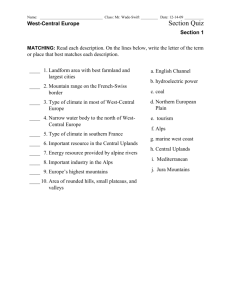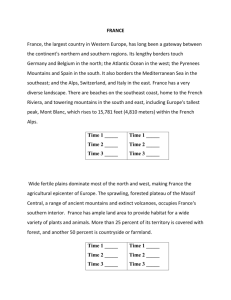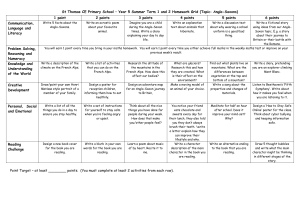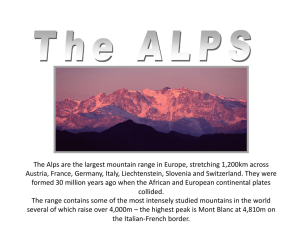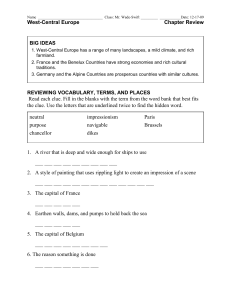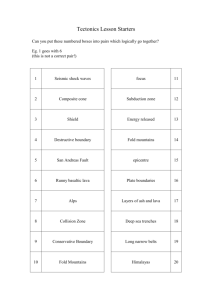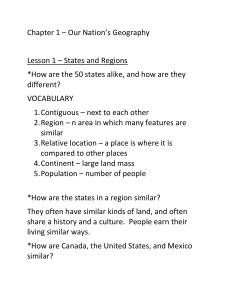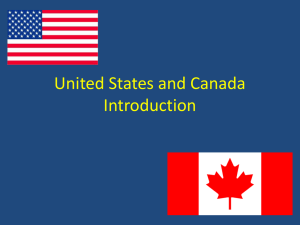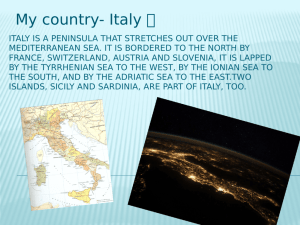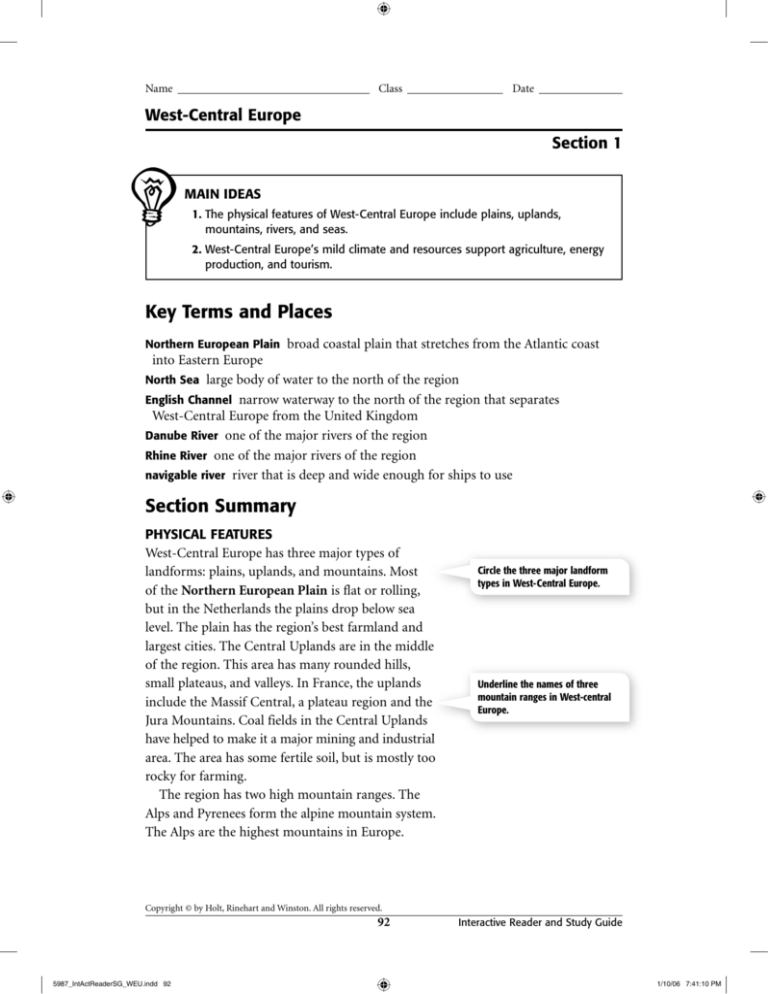
Name
Class
Date
West-Central Europe
Section 1
MAIN IDEAS
1. The physical features of West-Central Europe include plains, uplands,
mountains, rivers, and seas.
2. West-Central Europe’s mild climate and resources support agriculture, energy
production, and tourism.
Key Terms and Places
Northern European Plain
broad coastal plain that stretches from the Atlantic coast
into Eastern Europe
North Sea large body of water to the north of the region
English Channel narrow waterway to the north of the region that separates
West-Central Europe from the United Kingdom
Danube River one of the major rivers of the region
Rhine River one of the major rivers of the region
navigable river river that is deep and wide enough for ships to use
Section Summary
PHYSICAL FEATURES
West-Central Europe has three major types of
landforms: plains, uplands, and mountains. Most
of the Northern European Plain is flat or rolling,
but in the Netherlands the plains drop below sea
level. The plain has the region’s best farmland and
largest cities. The Central Uplands are in the middle
of the region. This area has many rounded hills,
small plateaus, and valleys. In France, the uplands
include the Massif Central, a plateau region and the
Jura Mountains. Coal fields in the Central Uplands
have helped to make it a major mining and industrial
area. The area has some fertile soil, but is mostly too
rocky for farming.
The region has two high mountain ranges. The
Alps and Pyrenees form the alpine mountain system.
The Alps are the highest mountains in Europe.
Circle the three major landform
types in West-Central Europe.
Underline the names of three
mountain ranges in West-central
Europe.
Copyright © by Holt, Rinehart and Winston. All rights reserved.
92
5987_IntActReaderSG_WEU.indd 92
Interactive Reader and Study Guide
1/10/06 7:41:10 PM
Name
Class
Date
Section 1, continued
Water is an important part of the region’s
physical geography. The Mediterranean Sea borders
France to the south. The Atlantic Ocean lies to the
west and the North Sea and the English Channel lie
to the north. The Danube and the Rhine rivers
are important waterways for trade and travel.
Several of the region’s rivers are navigable. These
rivers and a system of canals link the region’s
interior to the seas.
CLIMATE AND RESOURCES
Most of West-Central Europe has a marine west
coast climate. This is a mild climate with colder
winters. In the Alps and other higher elevation
areas, the climate is colder and wetter. In contrast,
southern France has a warm Mediterranean climate
with dry, hot summers and mild, wet winters.
The mild climate is a valuable resource. Mild
temperatures, ample rainfall, and rich soil have
made the region’s farmlands very productive.
Farmers grow grapes, grains, and vegetables. In the
Alps and the uplands, farmers raise livestock.
Energy resources are not evenly divided. France
has iron ore and coal. Germany has coal, and the
Netherlands has natural gas. Fast-flowing alpine
rivers provide hydroelectric power. Even so, many
countries have to import fuel. The Alps are another
important resource. Tourists come to the mountains
for the scenery and to ski and hike.
Circle two important rivers in the
region.
Why is a mild climate a valuable
resource for the region?
Circle the energy resources of
France. Underline the energy
resources of Germany and the
Netherlands.
In what way are the Alps an
important resource for the region?
CHALLENGE ACTIVITY
Critical Thinking: Evaluating Information How have landforms and
bodies of water affected activities in the region? Give support for
your answer.
Copyright © by Holt, Rinehart and Winston. All rights reserved.
93
5987_IntActReaderSG_WEU.indd 93
Interactive Reader and Study Guide
1/10/06 7:41:42 PM
Answer Key
Challenge Activity
SECTION 1
Ancient Rome made great achievements in art,
architecture, literature, law, and government.
The Renaissance inspired great works of art
and literature. Part of Italy’s economy today
is based on tourist attractions from ancient
Rome and the Renaissance.
Call-Out Boxes
1. plains, uplands, mountains
2. Jura Mountains, Alps, Pyrenees
3. Danube and Rhine
4. Mild temperatures, ample rainfall, and
rich soil have made the region’s farmlands
very productive.
5. France has iron ore and uranium;
Germany has coal; the Netherlands has
natural gas.
6. Tourists come for the scenery and to ski
and hike in the Alps.
SECTION 4
Call-Out Boxes
1. Phoenicians, Greeks, Romans, Moors
2. the Americas, Africa, Asia
3. the Basques
4. round arches, elaborate tilework
5. a king rules with the help of an elected
Challenge Activity
Several rivers are navigable. They link the
region to the sea through a system of canals.
Many cities and industrial areas sit along the
banks of these rivers. Tourists ski and hike the
Alps and enjoy the scenery.
parliament
Challenge Activity
Spain and Portugal share common histories
and many cultural features. However,
today they have different governments and
languages. Students should support their
explanation with details from the chapter.
SECTION 2
Call-Out Boxes
1. Romans, Franks, Normans
2. He conquered most of Europe, creating a
West-Central Europe
vast empire, which ended in 1815 when
European powers defeated his armies.
3. The French share a common heritage.
Most speak French and are Catholic. The
French share a love of good food and
company.
4. Belgium, the Netherlands, and
Luxembourg
5. Their location has led to invasions but
has also promoted trade. All are densely
populated, lie at low elevations, between
larger, stronger countries, and have strong
economies and democratic governments.
COMPREHENSION AND CRITICAL
THINKING
1. Size—both large countries with large
populations, strong economies, and many
natural resources; Culture—proud of
their long histories of achievements in
arts, literature, music, and the sciences;
Influence—dominant European powers
with leadership positions in European
government and politics.
2. Alpine Countries—the scenery of the
Alps attracts tourists; the work of many
skilled craftspeople helps the economy.
Benelux Countries—made use of
harbors and central location in Europe
to become major centers of international
trade, headquarters for international
organizations, and banking centers.
3. During both world wars, German forces
occupied parts of France.
Challenge Activity
Their location has led to invasions but has also
promoted trade.
SECTION 3
Call-Out Boxes
1. to stop East Germans from escaping
2. Democracy movements swept Eastern
Europe and communism collapsed.
3. Most people are either Protestant or
Catholic, although some East Germans
have no religious ties.
Copyright © by Holt, Rinehart and Winston. All rights reserved.
211
5993_IntActReaderSGAK.indd 211
Teacher Management System
1/13/06 4:51:07 PM

